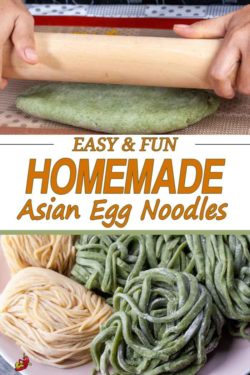Making homemade egg noodles will give you fresh and tasty egg noodles to use straight away. They’ll taste so much better than the dried versions. Just follow along with our easy noodles recipe and you will see!
Video Demonstration of Making Homemade Egg Noodles
Link to Video on Making Egg Noodles at Home in case it fails to load for you
They are simple to make and there is little to go wrong aside from rolling out the made noodle sheets which takes a bit of effort and keeping them neither too dry or too wet.
That makes it a good fun recipe to make with kids but the Emoji Chocolates are tastier!
This dough recipe used to make egg noodles is also good for making wonton and kiew when used in the flat sheet form. So if you are using this recipe to make egg noodles how about checking out our recipes on Ba Mee Kiew Nahm – the equivalent of chicken noodle soup in Thailand, and Stir Fried Pork with Egg Noodles as a couple of ideas.
If you want to make gyoza which is very similar then the recipe is slightly different, no eggs mainly, but the process is the same except the sheets are rolled a lot thinner. Enter your pasta maker to make that easy.
Links disclosure: Some links on this page go to affiliate partners where, without cost to you, we may receive a commission if you make a purchase.
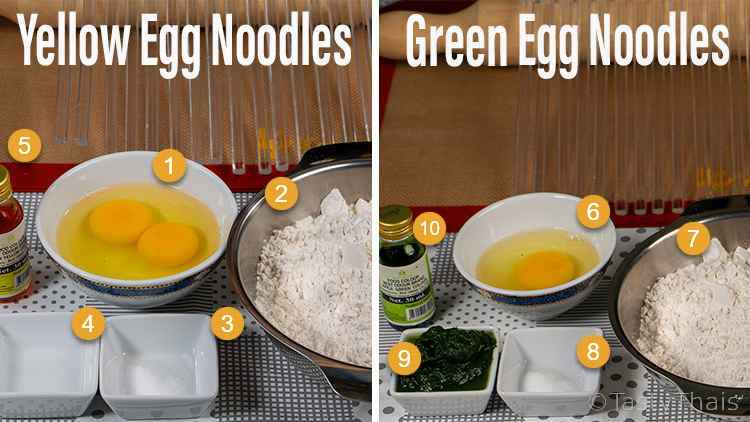
Homemade Egg Noodles Ingredients – What You’ll Need
- Flour
- Eggs
- Salt
- Water
- Pureed Spinach if making green noodles (Mee Yok)
Optionally butter or olive oil for eating your egg noodles naked. And if you love the color yellow you might want to drip in a couple of drops of food coloring. Personal preference there. Just mix in the butter or oil and adjust water as you make the dough.
A note about the flour – All-purpose, rice, semolina or tapioca flour or a mix. The finer flours give nice dainty noodles that are soft and lovely and the coarser all-purpose flour noodles with a bit more oomph. Choose your noodles style as the mood takes you.
By the way, making noodles is fun for kids, especially if they are stuck at home for the holidays and feeling a little bored. So get your kids cooking and relieve some stress at the same time – or at least change it to a different kind of stress haha.
Thai Egg Noodles vs Western Style Egg Noodles
With homemade egg noodles, we get the chance to adjust the ingredients depending on whether you intend to use them in a Thai dish where they are cooked with sauce or soup (no butter) or stir-fried or to eat as a side dish to accompany a Western-style meal where it’s good to add a little butter to the ingredients.
Adding butter makes the dough a little easier to roll, but it’s a marginal thing but adds to the taste. Butter is not used much in traditional Thai cooking and in any case adding it will not make much difference to the taste of egg noodles when they are swimming in soup or doused in sauce.
So if you intend to make these strictly to eat as you would spaghetti then add a little butter or olive oil to the mix – meaning about 1½ teaspoons of either per cup of flour. Olive oil pairs better with Italian dishes and butter with everything else and for eating on their own cook with quality chicken stock and top with a little butter, a sprinkle of parmesan cheese, chopped cilantro and green onion tops to garnish. Oh yum!
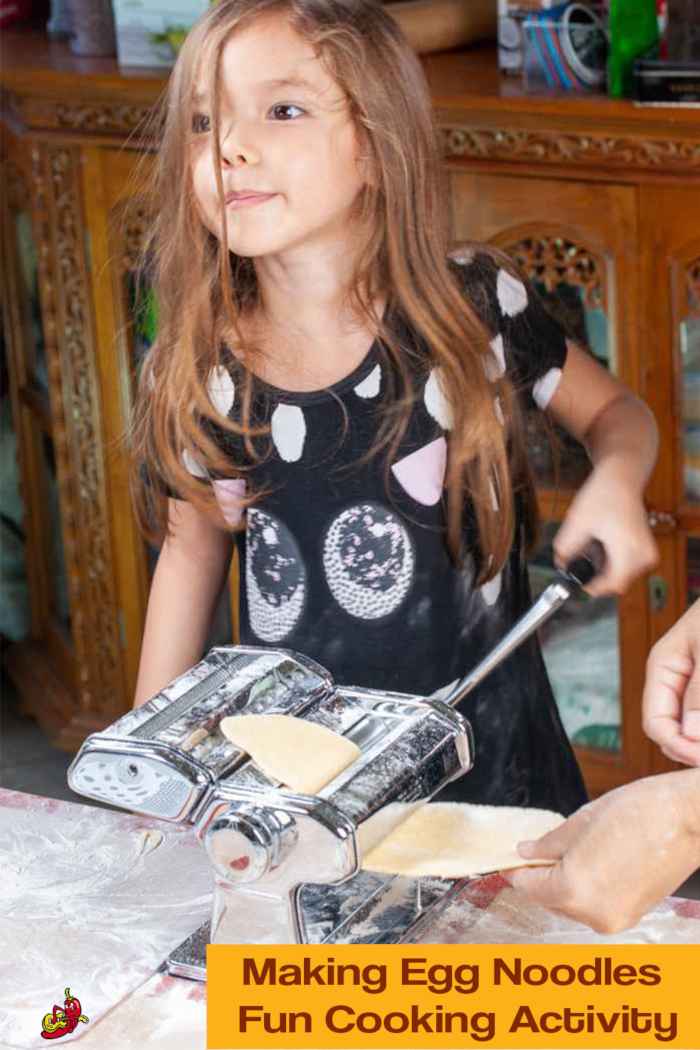
How to Make Noodles – Equipment to Use (or not)
You will need to think for a millisecond to decide how to approach making homemade egg noodles. If you are only going to make a small quantity using a couple of cups of flour then it really isn’t worth getting out the electric appliances because the cleaning up is more hassle than the making.
If you are making a bigger quantity then you might want to get out your electric stand mixer and dough hook or an electric hand mixer if you have one with a dough hook attachment.
For large quantities, you will save a little on the prep time using a mixer but more time washing up!
The other issue is rolling out the egg noodle sheets. Again it depends on the quantity that you intend to make and also the shape of the final noodles.
If you are dead set on making uniform spaghetti sized noodles or fine stranded noodles then you will want to get out the pasta machine with its attachments. It makes rolling a whole lot simpler and less effort and certainly helps get a more uniform-sized pasta.
Other people dislike uniforms and are pleased more with the avant-garde, hand-made look of noodles where each has their own individuality. For that just cut them yourself – no matter how careful they will not be the same size.
Rolling out really needs to be thought about because the resultant sheet dough needs to be quite thin 2-3mm or 1/8th – 1/10th inch – and consistent. You also need to control the moisture in the dough a little more if rolling out manually.
Types of Egg Noodles
There are a few types of egg noodles. Ba Mee Khai or yellow egg noodles are the plain egg noodles you get in Thai soups and broths and also the type used for making kiew (egg noodle dumplings). The type used for dumplings tends to be more often made with rice flour than all-purpose which makes for a more delicate and softer texture than all-purpose.
Mee Yok – are the green colored egg noodles which you also see in Thai soups and which are made using vegetable juice and pulp from kale or spinach.
Pan Keow is egg noodle dough rolled out into sheets – later cut with a pastry cutter to make parcels to hold the kiew fillings.
How to Make Homemade Egg Noodles (Ba Mee Khai & Mee Yok) – Step by Step
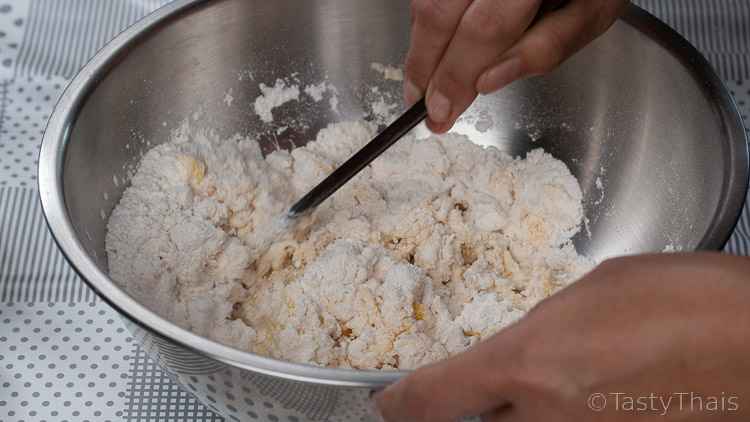
Step 1a Making the Dough for Ba Mee Yellow Noodles
Start by putting the all-purpose flour into a bowl. Make an indentation in the center and push to the sides making a sort of volcano shape.
Break in the eggs and mix together as you go sprinkling in the salt, mixing and breaking apart the dough and kneading to get a regular consistency. Add in a little water to keep a doughy consistency but don’t make it too wet as it will settle as you mix it.
Remove the dough from your bowl and onto a clean, flat surface dusted with flour. Our preference is to use a silicone baking mat, pressing and folding the dough in on itself and pressing it together with the heels of your palm and repeating.
Knead for 4-5 minutes before rolling into a ball. Cover and seal with plastic wrap or film and set aside to rest for 10 to 15 minutes.
The resting period is important to let the water, eggs, and flour absorb together which will make for a more consistent finish.
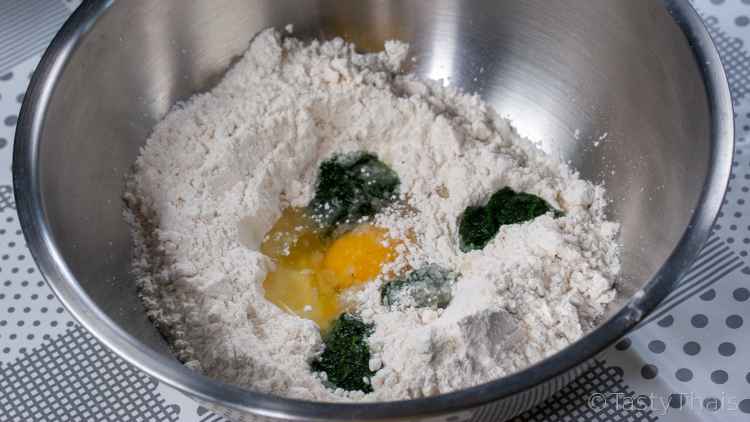
Step 1b Making Dough for Mee Yok Green Noodles
The process for making the mee yok noodles is essentially the same as for the Ba Mee noodles above.
However, you will be using wet pureed cooked spinach to provide natural green coloring. This gives a nice speckled look to the finished noodles which looks sort of healthy for some reason.
You can also use kale and cook it, blend it with water and then strain it out but you end up with a consistent green noodle sheet rather than the attractive speckled version when using pureed spinach.
So follow along Step 1a but use the pureed vegetable and juice instead of the initial water and then adjust for dryness with extra water as you go.
In the video above you will see the green dough was a little too dry. We should have added a little more water to compensate, preferably before resting it but a sprinkle of water can be added afterward too. As a result, the effort needed to properly roll out the dough was too much.
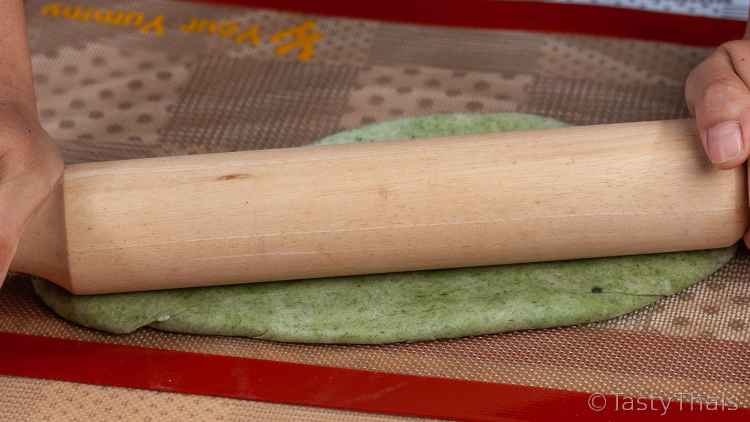
Step 2a Rolling the Dough – Manually
If your dough is much too dry it will not stick together properly so if it looks like it might break apart as you fold it over on itself then add a bit more water to moisten it.
On the other hand, if it’s is too wet then use flour dusted on the kneading mat and continue kneading. The dough will absorb the flour and in turn absorb the wetness of the dough.
After a while, you will intuitively know when the dough is at the right consistency. Damp to the touch but not sticky and pliable so as not to break apart when bent out of shape.
Before rolling the dough, take your ball of dough and unwrap it. Squash it out into a flatter shape with the heels of your palm and use your fingers to push it into a bigger area.
This process gives you a feel for the dough, whether it needs moistening or flouring to adjust as well as getting a head start on the rolling process.
Finish off with the Roll out the dough working lengthwise, then crossways and then diagonally to spread it out in a consistent thickness of about 1/8 to 1/10th inch or 2-3mm.
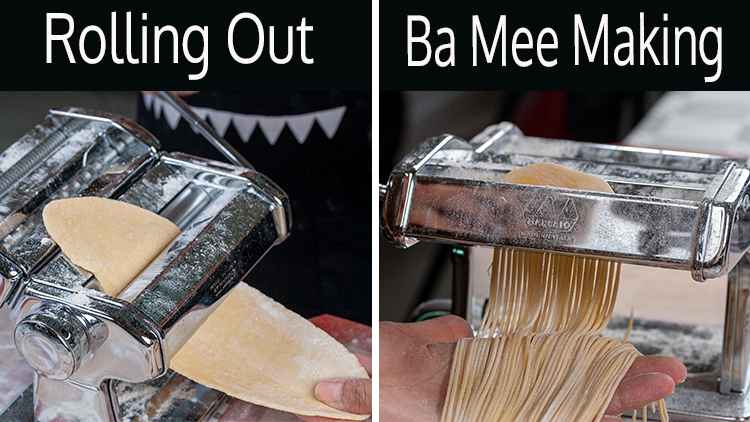
Step 2b Rolling the Dough – Pasta Machine
Rolling with a pasta machine is much, much easier.
Once again you will unwrap the dough from its plastic resting wrapper and push down onto your floured kneading mat.
This time you push the dough sort of flat and can flatten further with a quick roll of the rolling pin. Fold the dough in on itself to form a long rectangle and then roll it up making it into a large sausage shape about 1½ to 2 inches (35 to 50mm) thick,
Cut off a piece of dough about 2 inches (50mm) thick and cover the remainder with a damp muslin cloth to stop it drying out.
With mats either end of the pasta machine, dust them with a fine layer of flour and a dusting of flour to the machine rollers as well.
Take the cut piece of dough and pass it through the machine set with the rollers as far apart as possible. Pass through the rollers once, fold in each end of the dough towards each other to the center and then pass through a second time before closing the rollers one step closer.
Repeat the rolling process again and fold the dough in on itself again at the first pass through and then roll again. Repeat on the next closer setting and so on until the dough is the required thickness. For our Marcato Atlas 150 we rolled through to a thickness setting of 4 which was thin enough.
Step 3a Making the Noodles Manually & Using the Sheet Noodles
You should now have a consistently flat sheet of egg noodle dough.
You can use a pastry cutter to cut out wrappers for kiew or gyoza. Or you can make into egg noodles.
Egg noodles come in flat strips somewhat like tagliatelle pasta which we call ‘mee sen ban’ (roughly translates as flat egg noodles) or in long round strands somewhat like spaghetti which we call ‘sen ba mee khai or ba mee luang sen glom’ (roughly translates as round egg noodles). Ba Mee simply means egg noodles without specificity on the shape. Ba Mee Yok means the green color egg noodles.
To be honest, most Thais tend to describe the noodles rather than go through the misunderstanding of what words mean what specific type of noodles. Phew complicated sometimes!
So if you are doing this manually you cannot really make the round noodles. But you can make teh flat type easily. Just fold over the long rolled out sheet and fold it over on top of itself to make several layers. Then slice through in small widths. You can then open out the cut noodles into long lengths and dust them over with flour to stop them sticking to each other.
Finally hang them over something for about 20 mintues to dry off a little before cooking.
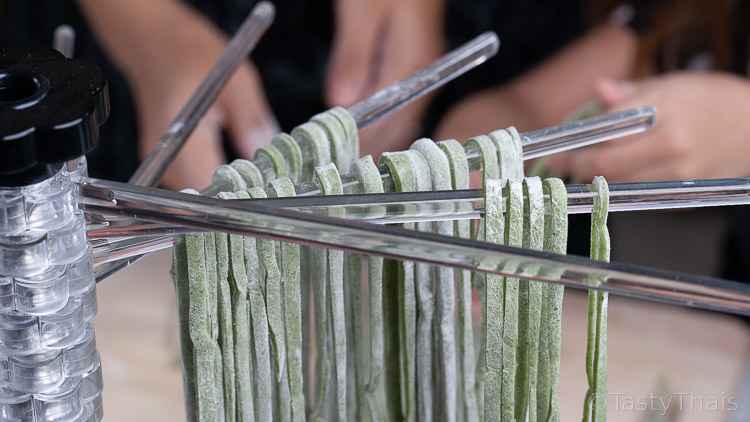
Step 3b Making Noodles Using the Pasta Machine
Making noodles with the pasta machine is a breeze.
Just choose the larger round cutter attachment or the flat tagliatelle cutter attachment depending on what type of noodles you want.
Dust the cutters and pass the noodle sheet through to cut the sheet into your noodles. Once again dust with flour to stop them sticking and hang them out to dry for a little while.
Whichever method you use, if you are not cooking them immediately then roll the noodles up and cover with plastic wrap to stop them drying out.
They will last two or three days in the refrigerator.
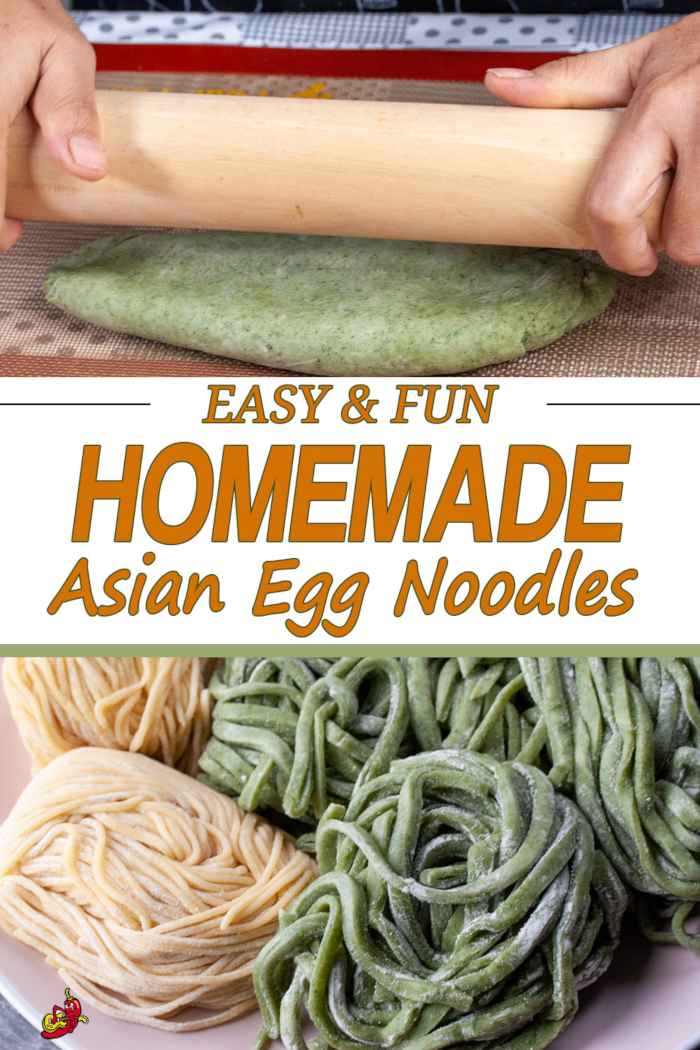
How to Cook Egg Noodles
Take your homemade egg noodles which should still be moist and pliable and shake off any excess flour on their surface.
Method 1 Boil and Serve
If you made your noodles with butter or oil for eating as is then boil water, in a large pot 5 times or more larger than the quantity of noodles. Add a little salt and drop in the noodles. Give them a gentle stir.
Your fresh noodles will cook very quickly, about 3 minutes should be enough. As they cook they will swell a little and plump up.
As soon as they are cooked drain off into a colander and quickly spray with cool water to remove any foam and take the edge off the surface heat. Don’t rinse so long they get cold – the object is a quick, sharp rinse.
Serve immediately.
Method 2 Cook in Soup
If you are making a Thai soup such as Ba Mee Geow then you simply cook the noodles in the soup stock for a few minutes as you cook the other soup ingredients.
To do this you need to rinse in hot water to get rid of the flour before you stick them in your soup stock otherwise you will end up with cloudly soup with all the flour in it.
Method 3 Stir Fried
In fact this is the same as method 1 or method 2 depending on whether you want the special extra taste of cooking in stock. Anyhow, you need to boil the noodles to cook normally and then cook more in the stir fry.
Do not just stir fry the homemade egg noodles.
Homemade Egg Noodles Recipe
Homemade Asian Egg Noodles Recipe – Fun with Kids
The Video showing this recipe being cooked is near the top of the page – A convenient Jump Link to the video is below the description under here.
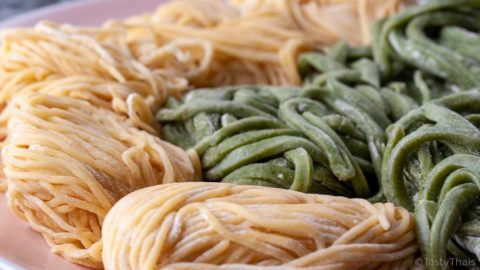
NOTE: Any In-recipe images can be toggled on and off with the camera icons next to the Instructions header.
Equipment
- Rolling Pin
- Pasta Machine (optional)
- Plastic Wrap
- Silicone Baking Mat (optional)
- Knife
Ingredients
Ingredients For Yellow Egg Noodles
- 2 cups All Purpose Flour
- 2 Eggs
- ½ tsp Salt
- 1 tbsp Water
Ingredients For Green Egg Noodles
- 2 cups All Purpose Flour
- 1 Egg
- 1 tsp Salt
- ¾ cup Spinach Puree
Instructions
Making Homemade Yellow Egg Noodles Dough
- Put the flour into a mixing bowl and make a crater in the center. Break your eggs into the crater and sprinkle in the salt.
- Use your fingers, a fork, chopsticks or a mixer (on low speed) with a dough hook to mix the eggs together adding water gradually as you go. (See 4:20 to 6:20 in the video)
- When the dough starts to form a ball you will need to use your hands to knead the dough in the bowl into a consistent ball, running it around the edges of the bowl to accumulate all the bits left on the sides.
- Take the dough and place it on a floured baking mat, kneading it thoroughly for at least 5 minutes. Turn the dough in on itself and press in with the heels of your palm, press in with your fingers and repeat, turning, folding, and pressing continuously.
- If the dough seem to pull apart as you fold it in then your dough is too dry. Just sprinkle a few drops of water on the surface and knead more until it feels moist but not sticky to the touch.
- If the dough feels too wet and is difficult to work with, sticky to the touch, then it is probably too wet. Just lightly dust with flour on the flattened surface and/or dust the work surface. Using a silicone type baking mat is a great surface to work with and easy to clean.
- Once the dough is nice and consistent, seal it up in plastic wrap and let it sit for 10-20 minutes – the time is not so important. This allows the water, flour, and eggs to get to know each other a little better and give you an easier time rolling out.
Making Green Egg Noodle Dough
- The process for making the green noodles is almost the same as for the yellow egg noodles above.
- Before you start, cook enough spinach to make a few tablespoons of wet puree.
- Add flour, egg as described for the yellow noodles adding a tablespoon or so of puree at the beginning as you mix. Add more puree or water to adjust to the color you want and to get the right level of moistness in the dough. Wrap in plastic wrap and rest for 10-20 minutes. (See 3:00 to 3:50 in the video)
Manual Rolling & Noodle Making
- After the dough has rested, dust your worksurface with flour, unwrap the dough and press it flat with your fingers, pushing outwards to expand the surface and flatten a good deal before you start rolling with a pin.
- Dust the surface of the rolling pin finely with flour and roll the dough out to about 1/8th to 1/10th inch (2-3mm) thick depending on how thick you like your noodles.
- Roll the dough up and down, side to side, and diagonally to get it consistently flat and longer than it is wide in a sort of rectangularish shape. (See 6:40 to 7:50 in the video)
- To make the noodles, working with your flattened dough, fold it in on itself in layers back and forth about 3-4 inches (7-10cm) wide, and then cut with a sharp knife into narrow strips. (See 7:54 to 6:20 in the video)
- After cutting into strips, tease them out into long strips by unfolding your folds, dust with flour and hang them out to dry.
Rolling and Making Noodles with a Pasta Machine
- Much easier than all that manual rolling is the pasta machine method.
- Set up your pasta machine securely and dust the rollers with a little flour. Take the rested noodle dough and roll it up into a large sausage. Cut the sausage with a knife into segments a about 2 inches (50mm) thick. The thickness is not critical but the thicker each segment the longer the sheet will be coming out of the pasta machine which eventually gets a little difficult to manage.
- Take one of your cut segments and cover the rest with muslin to keep them moist and stop them drying out while you play.
- Press down to flatten the segment of dough out a little and ensure your pasta machine rollers are set to their widest setting. On my Marcato Atlas 150 that is setting 0.
- Roll the flattened lump through the rollers and support the flattened dough at the same time as catching it with a flat palm as it comes out. (See 10:00 to 12:20 in the video)
- Taking your now larger, thinner and flatter pice of dough, fold the ragged and mis-shaped ends back in toward the center of the piece and pass through the pasta machine again.
- Turn the roller setting one stop closer. 1 on my machine. Fold over your dough sheet from the last pass in on itself again and roll through on this thinner setting. Dust the rollers a little if the dough needs it. Once again fold the dough in on itself as before and pass through again.
- Repeat this process, setting the pasta machine rollers one step closer each time until the dough is the required thickness. For me a roller setting of 4 to 5 is thin enough.
- You should now have a nice flat, long piece of noodle dough to pass through your machine cutters to make either uniform flat noodles as the manual method produces or round spaghetti like ones depending on the cutter you use.
- Just set up which cutters you want and dust again with a little flour. Hold the dough with one hand, yell for the kids to help turn the handle and watch your noodles appear. You can totally do this on your own but its more fun with two!
- As the noodles come out give them a quick dusting with flour and them hang them on a noodle drier if you have one test the improvisation skills of the kids for a suitable hanger if you don't – like a clean tea towel over the back of a chair for example.
Notes
Nutrition

Planning on Making this Recipe?
It would be great if you could take a picture of your finished creation and share it out on Instagram. Tag me with #TASTYTHAIEATS – I love to see your ideas!
Frequently Asked Questions About Egg Noodles
What is the Difference Between Egg Noodles & Pasta?
The real answer is not much! Pasta is made with a little olive oil and the type of flour makes a significant difference to the finished pasta. Fine ground flours, semolina flours and regional flours all affect the taste a little. With egg noodles you use either all purpose flour or a mix of all purpose with rice or tapioca flours. There is no ‘One’ perfect recipe as romantic as that sounds.
Are Egg Noodles Gluten Free?
If you use a non-wheat gluten free flour such as rice or tapioca flour then the noodles will be gluten free. Check the flour packaging to be sure. If buying store bought egg noodles then you will have to rely on the packaging and ingredients list.
How Do You Make Homemade Egg Noodles from Scratch?
Make a dough from 1 egg, 1 cup flour, a little salt and water. Knead it well and let it stand for 10-15 minutes. Roll the dough flat with a rolling pin and then fold the flat sheet on itself several times, cut with a knife and open out the flat noodles or use a pasta machine or similar to make round noodles.
How Long do Egg Noodles Need to Dry?
Egg noodles are best made fresh and kept a little moist to use within a few days. For this they need to dry only slightly to stop sticking so about 20 minutes. For dried egg noodles similar to shop bought you will need to air dry several days in a clean, dry environment (inside and oven) or use a dehydrator. But why would you?
Do You Have to Let Egg Noodles Dry?
It is best to let fresh, homemade egg noodles dry a little before cooking or storing so that they do not stick together which they will do even if you flour as you should. The noodles should not dry out completely unless your intention is to make dried noodles. Egg noodles do not last a long time even if dehydrated!
I really hope you enjoy this dish and if you cook it I would love to hear your comments below so please come back and let me know how it turned out for you.

I am a Thai mum and love cooking for my children. Over the years, I have taken my family recipes as well as ones borrowed from friends and adapted them to make them even tastier. I publish my authentic Thai Food Recipes here for all to enjoy around the world. When I get a chance to travel I publish information to help others visiting Thailand.
